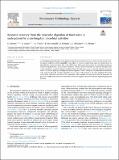Files in this item
Resource recovery from the anaerobic digestion of food waste is underpinned by cross-kingdom microbial activities
Item metadata
| dc.contributor.author | Nzeteu, C. | |
| dc.contributor.author | Joyce, A. | |
| dc.contributor.author | Thorn, C. | |
| dc.contributor.author | McDonnell, K. | |
| dc.contributor.author | Shirran, S. | |
| dc.contributor.author | O'Flaherty, V. | |
| dc.contributor.author | Abram, F. | |
| dc.date.accessioned | 2022-01-26T11:30:08Z | |
| dc.date.available | 2022-01-26T11:30:08Z | |
| dc.date.issued | 2021-12 | |
| dc.identifier | 277604271 | |
| dc.identifier | 34e51c75-697d-411f-b874-76243cd2e093 | |
| dc.identifier | 85122744271 | |
| dc.identifier.citation | Nzeteu , C , Joyce , A , Thorn , C , McDonnell , K , Shirran , S , O'Flaherty , V & Abram , F 2021 , ' Resource recovery from the anaerobic digestion of food waste is underpinned by cross-kingdom microbial activities ' , Bioresource Technology Reports , vol. 16 , 100847 . https://doi.org/10.1016/j.biteb.2021.100847 | en |
| dc.identifier.issn | 2589-014X | |
| dc.identifier.other | RIS: urn:A3AEFEAEA6FA8967BB98D8D975A4A166 | |
| dc.identifier.other | ORCID: /0000-0003-3516-3507/work/107287017 | |
| dc.identifier.uri | https://hdl.handle.net/10023/24752 | |
| dc.description | This work was supported by the Earth and Natural Sciences (ENS) Doctoral Studies Programme, funded by the Higher Education Authority (HEA) of Ireland through the Programme for Research at Third Level Institutions, Cycle 5 (PRTLI-5), co-funded by the European Regional Development Fund (ERDF). | en |
| dc.description.abstract | As the human population grows on the planet so does the generation of waste and particularly that of food waste. In order to tackle the world sustainability crisis, efforts to recover products from waste are critical. Here, we anaerobically recovered volatile fatty acids (VFAs) from food waste and analysed the microbial populations underpinning the process. An increased contribution of fungi relative to bacteria was observed throughout the reactor operation, with both kingdoms implicated into the main three steps of anaerobic digestion occurring within our systems: hydrolysis, acidogenesis and acetogenesis. Overall, Ascomycota, Proteobacteria and Firmicutes were found to drive the anaerobic digestion of food waste, with butyrate as the most abundant VFA likely produced by Clostridium using lactate as a precursor. Taken together we demonstrate that the generation of products of added-value from food waste results from cross-kingdoms microbial activities implicating fungi and bacteria. | |
| dc.format.extent | 9 | |
| dc.format.extent | 1488182 | |
| dc.language.iso | eng | |
| dc.relation.ispartof | Bioresource Technology Reports | en |
| dc.subject | 16S rRNA profiling | en |
| dc.subject | Anaerobic digestion | en |
| dc.subject | Metaproteomics | en |
| dc.subject | Resource recovery from waste | en |
| dc.subject | GE Environmental Sciences | en |
| dc.subject | QR Microbiology | en |
| dc.subject | DAS | en |
| dc.subject.lcc | GE | en |
| dc.subject.lcc | QR | en |
| dc.title | Resource recovery from the anaerobic digestion of food waste is underpinned by cross-kingdom microbial activities | en |
| dc.type | Journal article | en |
| dc.contributor.institution | University of St Andrews. School of Biology | en |
| dc.contributor.institution | University of St Andrews. Biomedical Sciences Research Complex | en |
| dc.identifier.doi | 10.1016/j.biteb.2021.100847 | |
| dc.description.status | Peer reviewed | en |
This item appears in the following Collection(s)
Items in the St Andrews Research Repository are protected by copyright, with all rights reserved, unless otherwise indicated.

